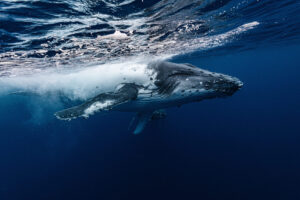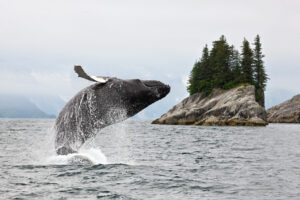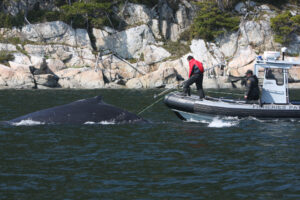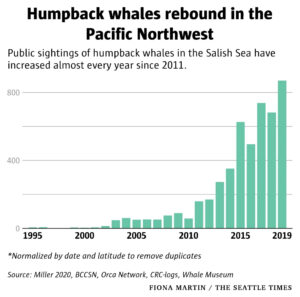On a sunny summer afternoon, conservationist Ian McAllister and I tacked north into Wright Sound aboard his trimaran mid-way between Bella Bella and Prince Rupert. We were five days into a 10-day adventure exploring remote islands and inlets along the central coast when a voice crackled over the two-way radio. It was Janie Wray. Since 2001, she and her partner Hermann Mueter have been studying humpback whales, orcas and fin whales from their remote research centre, Cetacealab, on Gil Island. Wray was excited. A pod of humpbacks had been spotted feeding nearby in Whale Channel and she was putting out the word to McAllister.
In 20 minutes we met Wray, bobbing in her powerboat in the lee of a rocky Princess Royal Island headland. The water boiled around us. Slowly, the massive head of a humpback whale emerged. Its jaw hinged wide open, inhaling krill and herring by the hundreds. Then another humpback surfaced for a mouthful of these tiny feeder fish. The pungent smell of whale breath mixed with the ocean brine. Scientists call this spectacle “bubble-net” feeding. Humpbacks have learned to confuse schools of fish by blowing large bubbles in the water, corralling and consuming them in huge numbers. Often more than a dozen whales will encircle herring or another schooling fish, then swim up through the centre with mouths wide open, devouring the prey. At least one whale in the group emits a feeding call, thought to be a way to coordinate the process and manipulate the fish. It’s an astonishingly clever and synchronized hunting technique for these leviathans that can weigh 40 tons when full grown.
Anyone who witnesses a feeding session like this can count themselves lucky. The knot of islands at the head of Douglas Channel is one of few places on the BC coast where humpbacks are known to regularly work as a team to bubble-net feed. Elsewhere this sort of feeding behaviour is normally a solo endeavour.
Humpbacks are fascinating creatures. As one of 14 species of baleen whale, they use keratinaceous plates, called baleen, in their mouths to filter and consume their meals. The humpback’s scientific name, Megaptera novaeangliae, is a reflection of its distinct wing-like flippers (“megaptera” means “large wing” in Latin.) They have one of the longest known migrations of any mammal, swimming thousands of kilometres from their tropical and sub-tropical calving grounds to feed along western North America and other nutrient-rich temperate coastlines (roughly between 35 and 60 degrees latitude in the southern and northern hemispheres.) Humpbacks communicate using a vocabulary of whale song. Males in particular are chatty. They sing long, complex songs from fall through the winter breeding season, which scientists believe play a role in courtship and mating. Though the song changes gradually, at any given time all males within a wintering area sing basically the same tune. As I learned that day in Whale Channel, humpbacks are innovative feeders. They deploy a range of strategies, including group and solo bubble-net feeding, lunge feeding, flick feeding and trap feeding. A single humpback can consume 3,000 pounds of food every day, twice the weight of a classic Austin Mini car. When they find a good fishing hole, where they know the tides and fish are plentiful, they tend to return to the same place. It’s known as “site fidelity” and in BC we’re lucky to have a rich and ecologically productive coastline that humpbacks love.
“Some of the individual humpbacks I have personally seen for the more than 20 years. They come back year after year to the same spots along our coast to feed,” says Jackie Hildering, co-founder Marine Education and Research Society (MERS,) a Port McNeill-based environmental non-profit.
It’s this kind of familiarity and intimacy that fuels Hildering’s passion for humpback conservation. As coordinator of the Canadian Pacific Humpback Collaboration, Hildering and her fellow staff at MERS contribute to a large multi-organizational effort, including that of Wray and Meuter at Cetacelab on Gil Island, to document and catalogue thousands of humpbacks, their habitat use, population trends and threats.
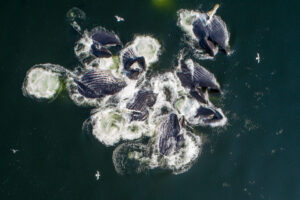
Humans have a long and, in modern times, fraught relationship with whales. For thousands of years the Nuu-chah-nulth people of the Pacific Northwest were one of numerous Indigenous cultures to harvest whales for meat and blubber. They were skilled hunters, pursuing humpbacks in dugout canoes and using harpoons tipped with razor-sharp mussel shells. They hunted them for sustenance and the spoils of the hunt were shared around the community.
With the onset of commercial whaling in the early 20th century, whalers began prowling the oceans in motorized ships armed with harpoon canons. The senseless, industrial slaughter of humpbacks and other species was relentless. Commercial whalers killed an estimated 3 million whales worldwide. Humpbacks were decimated to the point that approximately 5,000 individuals remained, a tiny fraction of the numbers that once freely roamed the world’s oceans. Between 1900 and the 1970s, whalers killed an estimated 32,000 of the North Pacific population, which includes the individuals that return to feed along the BC coast from their winter calving grounds along the coasts of Hawaii, Mexico and Central America. An estimated 1,600 were all that remained—barely enough to sustain the North Pacific population—when commercial whaling of humpbacks was finally banned in 1976. It was just in time. Since then humpbacks have made a remarkable recovery to the point where the population is estimated to be approximately 135,000 worldwide. It’s a testament that humans can take corrective and collective action to save a species.
But humpbacks are not out of trouble—climate change could now be the humpback’s biggest threat, along with ship strikes and entanglements in fishing gear. Wray and Hildering were two of the many co-authors of a study published in February, 2024, in the journal Royal Society Open Science. The study took a comprehensive look at the North Pacific population of humpback whales, including the estimated 7,000 that feed in the rich waters off BC.
The study had some good news. Between 2002 and 2012 the population nearly doubled from roughly 17,000 whales to 33,500 whales, growing at a respectable rate of nearly six percent annually. But there was also bad news. A sudden and dramatic ecological shift occurred off the west coast of North America between 2014 and 2016 when the Pacific marine heatwave took hold. Known as “the Blob,” this prolonged heatwave saw sea temperature spikes of between 3ºC and 6ºC above normal at depths from 50 to 200 metres. This unusually warm water had profound impacts. In the years following this marine heatwave, North Pacific humpback population trends shifted from positive to negative. Between 2012 and 2021,there was a 20 percent decline, equal to 7,000 whales. The reasons are easy to understand. The warmer the seawater, the less oxygen it holds and therefore the less biologically productive it is. Oxygen-poor water means fewer nutrients to nourish the foundation phytoplankton and zooplankton that sustain marine species all the way up the food chain to humpbacks. Warm water can also lead to toxic algae blooms.
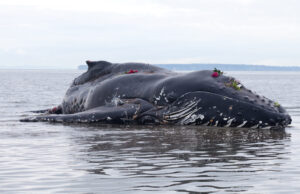
In the study, the researchers noted that “…the increased competition for diminished forage fish resulted in severely diminished presence of calves, prevalence of ‘skinny’ whales, increased strandings, and the absence of individual whales with high site fidelity to specific locales.” They concluded that the marine heat wave “appeared to have altered the course of species recovery with enduring effects,” adding that humpbacks will “serve as an indicator species for the ecosystem in the face of a changing climate.”
Interestingly, humpbacks along BC’s coast fared much better in the years following the heatwave than their relatives further up the coast in Alaska. There the humpback population experienced a 40 percent decline—twice the average rate of decline for the entire North pacific population. Hildering says this is because “the blob” persisted off the coast of Alaska well into 2016 when sea temperatures along BC had begun to normalize.
As of 2021, the Committee for the Status of Endangered Wildlife in Canada lists the North Pacific population of humpbacks as “Special Concern,” a status category for wildlife “that are particularly sensitive to human activities or natural events but are not endangered or threatened…”
So in many ways, humpbacks are in a relatively much better place today compared to 50 years ago when whaling fleets hunted their ancestors to the brink. However, the existential threat of climate change to humpbacks is real, as it is to countless species across the planet. So too is the danger of ship strikes and entanglement in fishing gear, but these threats are perhaps much easier to address than the complexities of reducing greenhouse gas emissions across international borders. It will take political and social will. Photo evidence gathered by MERS and other partners shows the scale of the problem.
“Our preliminary results, conducted in collaboration with Fisheries and Oceans Canada (DFO), show that around 50 percent of humpbacks in British Columbia have scarring that shows they have been entangled,” says Hildering.
Scars from entanglement are obvious but the blunt-force trauma of ship strikes rarely leaves any visible marks. Whale researchers know of four large ship strikes of humpbacks on our coast in 2023. On July 5 of this year, boaters near Klemtu spotted a humpback with a missing fluke, or tail. Hildering and her team at MERS said scarring pointed to entanglement, while DFO speculated that a ship propeller likely severed the fluke. Either way, the animal was not expected to survive the injury. The challenge is most humpbacks sink to the bottom when the die. Only rarely does one wash ashore and allow scientists to perform a necropsy that’s necessary to determine the exact cause of death.
A recent study led by University of British Columbia scientist Rhea Storlund shed further light on the entanglement challenge. Storlund stepped out of her normal area of research interest focusing on the physiology of sea lions to investigate a little known facet of human threats to humpback whales—entanglement in fish farm netting.
Between 2008 and 2021, Storlund and her co-researchers learned of eight such entanglements, typically occurring when a humpback gets caught between the predator control net and the net containing the farmed fish. Three entanglements resulted in the whales dying, while five were freed and saved.
“The humpback whale—fish farm story hadn’t been told yet. We knew of the three deceased whales but weren’t sure how many other interactions there had been,” explains Storlund. “Humpback whales are an iconic species with major cultural and economic significance to BC that are making a comeback post-whaling and we wanted to learn more about what kind of a conservation risk fish farms pose to them.”
What’s perhaps more interesting is that fish farm entanglements accounted for just six per percent of the roughly 125 known events over that 13-year period in which a humpback got caught in fishing gear on the BC coast. That’s only the entanglements that people report to Fisheries and Oceans Canada, and it represents a mere microcosm of a global problem that some believe could see tens of thousands of whales, dolphins and sharks dying in fishing gear annually.
Hildering views this knowledge as both troubling and as an opportunity for humpback conservation. One potential solution is innovative fishing gear that uses less rope. In 2022, the Canadian Wildlife Federation launched a lending program on Canada’s East Coast aimed at protecting the endangered North Atlantic right whale. The program allowed fishers to test new gear that, for example, holds ropes at a depth that doesn’t interfere with whales or uses rope with a lower break-strength threshold.
There is a catch; this innovative gear is very expensive.
“There would have to be subsidies for commercial fishers to make this work,” Hildering says.
When it comes to ship strikes, conservationists believe go-slow zones and much better real-time monitoring of humpback whale presence in shipping lanes would allow captains to alter course and avoid strikes.

Early on a spectacular spring morning a few years ago my wife, two daughters and I awoke in our berth aboard the MV Northern Adventure as the sun rose over the Pacific. It had been a long 17-hour journey from Bear Cove on the northern end of Vancouver Island. We were in for a sunrise treat as the ferry steamed north past the Fairview Container Terminal toward Prince Rupert. A few hundred metres to starboard, a pod of humpbacks spy hopped in the calm water, their black-grey heads glistening. Known for their curiosity, humpbacks—as well as Orcas—are prolific spy hoppers, raising their heads above the surface to inspect their surroundings, be it a tourist boat full of whale watchers or a passing BC ferry. It was a wonderful welcome to Prince Rupert and another humpback encounter I’ll never forget. We’re human. We always hope for more such encounters with nature that give us hope for the planet. For humpbacks, it all boils down to how much we’re willing and able to adapt to live in harmony with the big animals of our oceans. We did it when countries banded together to stop the slaughter of humpbacks. The question is, can we do it again and mitigate the threats of climate change, ship strikes and fish net entanglements?
“Education is important, because ultimately people will decide how important individual whales are,” says MERS founder Jackie Hildering. “I really see whales as barometers of human values.”
